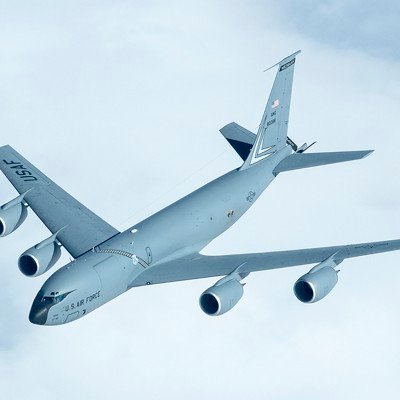One startup has an Air Force contract to retrofit KC-135 tankers and C-130 cargo planes for autonomous flight, and another has developed an AI pilot for DARPA’s air combat program. Now the two are joining forces.
Boston-based Merlin Labs said last week it was acquiring California-based EpiSci, whose AI helped give Air Force Secretary Frank Kendall a swanky flight in an F-16 last month.
EpiSci and its subsidiary PhysicsAI are the only team to have participated in all three chapters of DARPA’s effort to develop an AI fighter pilot: the 2020 Alpha Dogfight Trials, the 2020-24 Air Combat Evolution program, and, as of last week, the Enhanced Artificial Intelligence program. Of the four companies that operated AI agents on Kendall’s flights, EpiSci CEO Bo Liu said his company’s AI agent was “the most trusted and best performing.”
Merlin, which is building its own AI pilot, plans to test its AI on an Air Force KC-135 tanker sometime next year, CEO Matt George said. This “core” pilot would allow the Air Force to reduce the number of pilots on board from two to one, freeing up more crew members and allowing the Air Force to observe the AI in action on real missions with humans alongside it, he said.
If the EpiSci deal closes as expected within the next few months, Merlin will be able to equip its core pilots with advanced skills, such as qualifications for the F-16, which would make the company the first to offer AI pilots capable of a range of missions, George said.
In February, Merlin signed a contract with the Air Force to demonstrate its AI pilot on a KC-135. Last week, the company was awarded a $105 million contract to put the pilot on a C-130 transport plane. The company plans to start work on the KC-135 in the coming months and fly the aircraft with its autonomous system next year, George said. Then it will move on to testing the C-130.
“Lockheed Martin, Northrop and other big names are great at what they do, but ultimately it’s going to be companies like us that can provide true autonomy that can complement some of their traditional platform structures, services and infrastructure,” George said.
Merlin’s recent contract and EpiSci acquisition come as the Air Force’s future looks increasingly unmanned. After flying with EpiSci’s AI pilot, Secretary Kendall said he sees a future in which AI agents fly in combat and outperform humans. Air Force leaders have since become more cautious about plans to build another manned fighter, the NGAD project, showing that the technology is already having an impact.
“I think in the last few weeks there’s been a big groundswell of thinking about not just NGAD, but things like NGAS, next generation tankers, next generation mobility aircraft. I think there’s a growing voice saying, ‘Hey, if we project through these 20-year plans and given where we are today, we’ll be in a position within that time frame to be able to fly these aircraft without human crews,'” George said.
George said that while human pilots won’t become obsolete anytime soon, the future will be autonomous, and people aren’t yet fully prepared for how quickly that will happen.
Liu said autonomous systems could alleviate some of the cognitive burden on fighter pilots, allowing them to focus on other tasks, such as managing drones. The Air Force is working on developing a collaborative fighter jet, which envisions autonomous drones flying alongside fighter jets.
“This gives us the opportunity to manage drones and unmanned or undermanned assets. So if I’m not busy flying a jet, and an AI can do some of those tasks, maybe not all of those tasks, but some of those tasks, I have the time, and I can cognitively manage, command and control multiple drones.” [are] “It gives me the freedom to go out and fight in a more hostile environment,” Liu said.
Liu declined to comment on the CCA program, but noted that EpiSci is a flagship part of DARPA’s AIR program, which will develop AI software for “multi-ship beyond visual line of sight air combat missions,” essentially creating an AI for teamed aircraft.
Asked about a timeline for the technology, Liu said EpiSci’s autonomy capabilities will be introduced gradually into aircraft and drones “trickle-in.” While the F-16 Kendall flew had to be modified to allow an AI to control the aircraft, Liu said new drones are being built with the company’s software in mind from the start.
“When it comes to drones working together, I think generally, technology-wise, we’re a year or two away from having a really well-designed AI that can take over from humans piloting,” Liu said.

